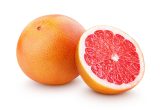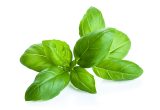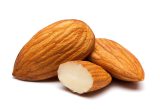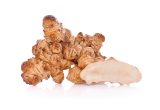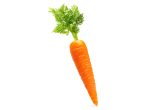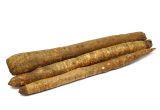Parsley

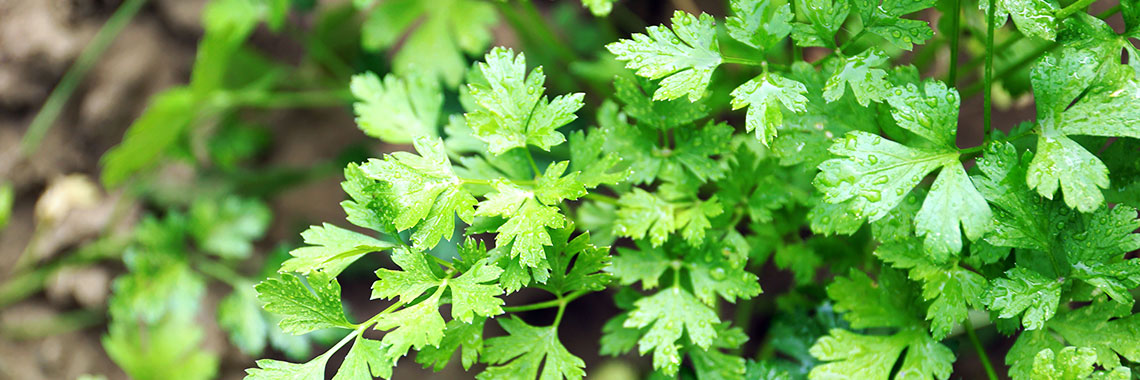
Description
- Parsley (Petroselinum crispum) belongs to the Apiaceae family.
- Parsley is one of the most widely produced plants in the world (Najla, 2012).
PHYSICAL AND ORGANOLEPTIC CHARACTERISTICS
- Parsley is grown and eaten for its leaves and roots and has three common varieties:
- Petroselinum crispum ssp. tuberosum (large-rooted or tuberous);
- Petroselinum crispum ssp. crispum (curled leaf);
- Petroselinum crispum ssp. neapolitanum (flat-leaved) (Dobričević, 2019).
- The characteristic odour of parsley is due to the presence of monoterpene hydrocarbons, mainly β-phellandrene, p-mentha-1,3,8-triene, 4-isopropenyl-1-methyl benzene and terpinolene (Alibas, 2019).
COMPOSITION CHARACTERISTICS (excluding macronutrients, vitamins and minerals)
- Containing notable contents of vitamins including vitamin C, minerals, essential oils, chlorophyll, polyphenols, carotenoids and other bioactive compounds, parsley has high antioxidant activities (Kuzma, 2014; Dobričević, 2019).
- Among polyphenols, flavonoids are particularly present, including apigenin, apiin, 6”-acetylapiin and catechins (Farzaei, 2013; Kuzma, 2014). Another study found the presence of apigenin-glucuronide, lucenin-2 and lithospermic acid, as well as p-coumaric acid derivatives (Kaiser, 2013).
- This plant is one of the main sources of apigenin, a flavone with chemopreventive properties. In particular, parsley is reported to have pro-apoptotic effects[1] on some melanomas and to inhibit the proliferation and migration of cancer cells in breast cancer (Danciu, 2018).
- Parsley also has high levels of quercetin, a flavonoid implicated in reducing the risk of neurodegenerative disorders, cancers, cardiovascular diseases, allergic disorders, thrombosis, atherosclerosis, hypertension and arrhythmia, due to its highly pronounced antioxidant and anti-inflammatory properties (Elumalai, 2016).
- Its notable contents of vitamin C and E, riboflavin, β-carotene and thiamine, give it diuretic and hypotensive effects (Alibas, 2019).
[1] Which stimulates programmed cell death.
RAW
The following values are approximate and depend on variety, season, ripeness, cultivation conditions, etc. Parsley provides an average of 43 calories (kcal) per 100 g, i.e. 180 kJ. However, it is used as a flavouring, so such a quantity is rarely consumed. Thus, for a portion of 5 g, parsley contains 2.15 calories (kcal), i.e. 9 kJ.
COMPOSITION TABLES
For each nutrient, the tables provide information on the content, minimum and maximum values for 100 g of parsley, while the percentage of the Dietary Reference Values (DRVs) is calculated for a 5 g portion.
MACRONUTRIENTS
| Constituent (g) |
Average content
per 100g |
Min-Max per 100g |
Average content
per 5g |
DRV% * |
|---|---|---|---|---|
| Water | 85,50 | 82,20 - 89,40 | 4,28 | - |
| Fibers | 4,30 | 3,10 - 5,10 | 0,22 | - |
| Carbohydrates | 3,48 | 3,20 - 3,90 | 0,17 | 0,07 |
| Sugars | 0,95 | 0,85 - 1 | 0,05 | 0,05 |
| Lipids | 0,63 | 0,40 - 1,20 | 0,03 | 0,05 |
| Saturated fat | 0,10 | 0,099 - 0,60 | 0,01 | 0,03 |
| Protein | 3,71 | 2,97 - 4,50 | 0,19 | 0,37 |
| Constituent (g) | Amount | Min-Max | DRV% |
|---|---|---|---|
| Water | Ciqual 2020 | - | - |
| Fibers | Ciqual 2020 | - | - |
| Carbohydrates | Ciqual 2020 | - | Règlement (UE) N°1169/2011 du parlement Européen, et du conseil du 25 octobre 2011 |
| Sugars | Ciqual 2020 | - | Règlement (UE) N°1169/2011 du parlement Européen, et du conseil du 25 octobre 2011 |
| Lipids | Ciqual 2020 | - | Règlement (UE) N°1169/2011 du parlement Européen, et du conseil du 25 octobre 2011 |
| Saturated fat | Ciqual 2020 | - | Règlement (UE) N°1169/2011 du parlement Européen, et du conseil du 25 octobre 2011 |
| Protein | Ciqual 2020 | - | Règlement (UE) N°1169/2011 du parlement Européen, et du conseil du 25 octobre 2011 |
Zoom on carbohydrates
- Its carbohydrate content is 0.17 g per 5 g serving.
- This amount corresponds to 3.48 g of carbohydrates per 100 g, which is lower than the average amount found in herbs (7.85 g per 100 g).
- Parsley is low in sugar* as it contains less than 5 g per 100 g.
Zoom on fibres
- For one serving of parsley (5 g), the amount of fibre is 0.22 g.
Zoom on proteins
- For a 5 g serving, parsley contains 0.19 g of protein.
- The amount of protein present in 100 g of parsley (3.71 g) is close to the average amount found in herbs (4.22 g per 100 g).
Zoom on lipids
- Parsley contains 0.03 g of fat for a 5 g serving.
- This amount corresponds to 0.63 g per 100 g, close to the average amount present in herbs (1.18 g per 100 g).
- Parsley is low in fat* as it contains no more than 3 g per 100 g.
*Regulation (EC) No 1924/2006 of the European Parliament and of the Council of 20 December 2006 on nutrition and health claims made on foods.
MINERALS AND TRACE ELEMENTS
| Constituent |
Average content
per 100g |
Min-Max per 100g |
Average content
per 5g |
DRV% * |
|---|---|---|---|---|
| Calcium (mg) | 218 | 94 - 354 | 10,90 | 1,36 |
| Chloride (mg) | 364 | - | 18,20 | 2,28 |
| Copper (mg) | 0,12 | 0,09 - 0,15 | 0,01 | 0,60 |
| Iron (mg) | 4,67 | 1,50 - 12,80 | 0,23 | 1,67 |
| Iodine (µg) | < 5 | 4,30 - 47 | 0,25 | - |
| Magnesium (mg) | 39,50 | 17,30 - 50 | 1,98 | 0,53 |
| Manganese (mg) | 1,70 | 0,16 - 5,30 | 0,09 | 4,25 |
| Phosphorus (mg) | 65 | 52,50 - 98,90 | 3,25 | 0,46 |
| Potassium (mg) | 598 | 443 - 768 | 29,90 | 1,50 |
| Selenium (µg) | 0,10 | NC - 0,20 | 0,01 | 0,01 |
| Sodium (mg) | 54,30 | 20,90 - 139 | 2,72 | - |
| Zinc (mg) | 0,77 | 0,46 - 1,07 | 0,04 | 0,39 |
| Constituent | Amount | Min-Max | DRV% |
|---|---|---|---|
| Calcium (mg) | Ciqual 2020 | - | Règlement (UE) N°1169/2011 du parlement Européen, et du conseil du 25 octobre 2011 |
| Chloride (mg) | Ciqual 2020 | - | Règlement (UE) N°1169/2011 du parlement Européen, et du conseil du 25 octobre 2011 |
| Copper (mg) | Ciqual 2020 | - | Règlement (UE) N°1169/2011 du parlement Européen, et du conseil du 25 octobre 2011 |
| Iron (mg) | Ciqual 2020 | - | Règlement (UE) N°1169/2011 du parlement Européen, et du conseil du 25 octobre 2011 |
| Iodine (µg) | Ciqual 2020 | - | Règlement (UE) N°1169/2011 du parlement Européen, et du conseil du 25 octobre 2011 |
| Magnesium (mg) | Ciqual 2020 | - | Règlement (UE) N°1169/2011 du parlement Européen, et du conseil du 25 octobre 2011 |
| Manganese (mg) | Ciqual 2020 | - | Règlement (UE) N°1169/2011 du parlement Européen, et du conseil du 25 octobre 2011 |
| Phosphorus (mg) | Ciqual 2020 | - | Règlement (UE) N°1169/2011 du parlement Européen, et du conseil du 25 octobre 2011 |
| Potassium (mg) | Ciqual 2020 | - | Règlement (UE) N°1169/2011 du parlement Européen, et du conseil du 25 octobre 2011 |
| Selenium (µg) | Ciqual 2020 | - | Règlement (UE) N°1169/2011 du parlement Européen, et du conseil du 25 octobre 2011 |
| Sodium (mg) | Ciqual 2020 | - | - |
| Zinc (mg) | Ciqual 2020 | - | Règlement (UE) N°1169/2011 du parlement Européen, et du conseil du 25 octobre 2011 |
Zoom on minerals and trace elements
- For a portion of parsley (5 g), the minerals and trace elements represent less than 5% of DRVs.
VITAMINS
DRV% * :
For a portion of 5 g.
Constituent
Average content
per 100g
Min-Max
per 100g
Average content
per 5g
DRV% *
Provitamin A Beta-carotene
(µg)
5 050
4520 - 5600
252,50
-
Vitamin A equivalent
(µg)
841,67
753,33 - 933,33
42,08
5,26
Vitamin B1
(mg)
0,10
0,086 - 0,15
0,01
0,45
Vitamin B2
(mg)
0,20
0,098 - 0,39
0,01
0,71
Vitamin B3
(mg)
1,51
1,02 - 2,30
0,08
0,47
Vitamin B5
(mg)
0,35
0,30 - 0,40
0,02
0,29
Vitamin B6
(mg)
0,15
0,09 - 0,30
0,01
0,54
Vitamin B9
(µg)
134
116 - 152
6,70
3,35
Vitamin C
(mg)
177
89 - 358
8,85
11,06
Vitamin E
(mg)
1,73
0,75 - 3,36
0,09
0,72
Vitamin K1
(µg)
1 220
360 - 5480
61
81,33
Constituent
Amount
Min-Max
DRV%
Provitamin A Beta-carotene
(µg)
Ciqual 2020
-
-
Vitamin A equivalent
(µg)
Calcul à partir de la valeur Provitamine A Béta-carotène*
-
Règlement (UE) N°1169/2011 du parlement Européen, et du conseil du 25 octobre 2011
Vitamin B1
(mg)
Ciqual 2020
-
Règlement (UE) N°1169/2011 du parlement Européen, et du conseil du 25 octobre 2011
Vitamin B2
(mg)
Ciqual 2020
-
Règlement (UE) N°1169/2011 du parlement Européen, et du conseil du 25 octobre 2011
Vitamin B3
(mg)
Ciqual 2020
-
Règlement (UE) N°1169/2011 du parlement Européen, et du conseil du 25 octobre 2011
Vitamin B5
(mg)
Ciqual 2020
-
Règlement (UE) N°1169/2011 du parlement Européen, et du conseil du 25 octobre 2011
Vitamin B6
(mg)
Ciqual 2020
-
Règlement (UE) N°1169/2011 du parlement Européen, et du conseil du 25 octobre 2011
Vitamin B9
(µg)
Ciqual 2020
-
Règlement (UE) N°1169/2011 du parlement Européen, et du conseil du 25 octobre 2011
Vitamin C
(mg)
Ciqual 2020
-
Règlement (UE) N°1169/2011 du parlement Européen, et du conseil du 25 octobre 2011
Vitamin E
(mg)
Ciqual 2020
-
Règlement (UE) N°1169/2011 du parlement Européen, et du conseil du 25 octobre 2011
Vitamin K1
(µg)
Ciqual 2020
-
Règlement (UE) N°1169/2011 du parlement Européen, et du conseil du 25 octobre 2011
Zoom on vitamins
- Parsley is high in vitamin K1 as it provides the equivalent of 81.33% of DRVs, i.e. 61 µg for a 5 g portion.
- Parsley also contains a significant amount of vitamin C as it provides the equivalent of 11.06% of DRVs, i.e. 8.85 mg for a 5 g portion.
- The other vitamins are present in smaller quantities in parsley, since they cover less than 6% of DRVs for a 5 g portion.
*Calculation made: Beta Carotene / 6 + retinol
POLYPHENOLS
| Constituent (mg) |
Average content
per 100mg |
Min-Max per 100mg |
Average content
per 5mg |
|---|---|---|---|
| Flavonoids (mg) | 306,57 | 0 - 581,68 | 15,33 |
| of which Flavonols (mg) | 3,33 | 0 - 9,68 | 0,17 |
| of which Flavones (mg) | 303,24 | 0 - 572 | 15,16 |
| Lignanes (mg) | 0,13 | 0,13 - 0,13 | 0,01 |
| Total polyphenols | 306,7 | 0,13 - 581,81 | 15,34 |
| Constituent (mg) | Amount | Min-Max |
|---|---|---|
| Flavonoids | Phénol-Explorer version 3.6 Méthode utilisée : Chromatographie après hydrolyse | - |
| of which Flavonols | Phénol-Explorer version 3.6 Méthode utilisée : Chromatographie après hydrolyse | - |
| of which Flavones | Phénol-Explorer version 3.6 Méthode utilisée : Chromatographie après hydrolyse | - |
| Lignanes | Phénol-Explorer version 3.6 Méthode utilisée : Chromatographie après hydrolyse | - |
| Total polyphenols | Phénol-Explorer version 3.6 Méthode utilisée : Chromatographie après hydrolyse | - |
Zoom on polyphenols
- Polyphenols are substances with an antioxidant effect.
- Flavones, a subgroup of flavonoids, are predominantly present in parsley composites, representing 98.96% of the total polyphenols identified.
- Flavonols and lignans are present in smaller quantities. They represent respectively 1.09% and 0.04% of the total polyphenols present in parsley.
Nutrition and health claims
According to the definitions of nutrition claims as presented in Regulation (EC) No 1924/2006 on nutrition and health claims, and in view of the composition of parsley, the following claims may be used:
NUTRITION CLAIMS OF PARSLEY
- High in vitamin K1 (5 g of parsley provide more than 30% of DRVs)
- Low in sugar (100 g of parsley contain less than 5 g of sugar)
- Low in fat (100 g of parsley contain less than 3 g of fat)
HEALTH CLAIMS (for a consumption of 5 g of parsley)
Vitamin K1
- Vitamin K1 contributes to:
- maintenance of normal bones,
- normal blood clotting.
References
- Agence nationale de sécurité sanitaire de l’alimentation, de l’environnement et du travail. Table de composition nutritionnelle des aliments Ciqual 2020. Consultée le 07/09/2020 depuis le site internet Ciqual https://ciqual.anses.fr/
- Alibas I, Zia MP, Yilmaz A. The Effect of Drying Methods on Color and Chlorophyll Content of Parsley Leaves. Turkish Journal of Agriculture – Food Science and Technology. 2019;7(6): 919–26.
- Danciu C, Zupko I, Bor A, Schwiebs A, Radeke H, Hancianu M, Cioanca O, Alexa E, Oprean C, Bojin F, Soica C, Paunescu V, Dehelean CA. Botanical Therapeutics: Phytochemical Screening and Biological Assessment of Chamomile, Parsley and Celery Extracts against A375 Human Melanoma and Dendritic Cells. International Journal of Molecular Sciences. 2018;19(11): 3624.
- Dobričević N, Šic Žlabur J, Voća S, Pliestić S, Galić A, Delić A, Fabek Uher S. Bioactive compounds content and nutritional potential of different parsley parts (Petroselinum crispum Mill.). Journal of Central European Agriculture. 2019;20(3): 900–10.
- Elumalai P, Lakshmi S. Role of Quercetin Benefits in Neurodegeneration. Advances in Neurobiology 2016;12: 229–45.
- Farzaei MH, Abbasabadi Z, Ardekani MR, Rahimi R, Farzaei F. Parsley: a review of ethnopharmacology, phytochemistry and biological activities. J Tradit Chin Med. 2013;33(6):815-26.
- Kaiser A, Carle R, Kammerer DR. Effects of blanching on polyphenol stability of innovative paste-like parsley (Petroselinum crispum (Mill.) Nym ex A. W. Hill) and marjoram (Origanum majorana L.) products. Food Chem. 2013;138(2-3):1648-56.
- Kuźma P, Drużyńska B, Obiedziński M. Optimization of extraction conditions of some polyphenolic compounds from parsley leaves (Petroselinum crispum). Acta Sci Pol Technol Aliment. 2014;13(2):145-54.
- Najla S, Sanoubar R, Murshed R. Morphological and biochemical changes in two parsley varieties upon water stress. Physiol Mol Biol Plants. 2012;18(2):133-9.
- Neveu V, Perez-Jiménez J, Vos F, Crespy V, du Chaffaut L, Mennen L, Knox C, Eisner R, Cruz J, Wishart D, Scalbert A. (2010) Phenol-Explorer: an online comprehensive database on polyphenol contents in foods. Database, doi: 10.1093/database/bap024. Full text (free access)
- Règlement (CE) N° 1924/2006 du Parlement européen et du Conseil du 20 décembre 2006 concernant les allégations nutritionnelles et de santé portant sur les denrées alimentaires.
- Règlement (UE) N°432/2012 de la Commission du 16 mai 2012 établissant une liste des allégations de santé autorisées portant sur les denrées alimentaires, autres que celles faisant référence à la réduction du risque de maladie ainsi qu’au développement et à la santé infantiles.
- Règlement (UE) n°1169/2011 du Parlement européen et du Conseil du 25 octobre 2011 concernant l’information des consommateurs sur les denrées alimentaires, modifiant les règlements (CE) n°1924/2006 et (CE) n°1925/2006 du Parlement européen et de Conseil et abrogeant la directive 87/250/CEE de la Commission, la directive 90/496/CEE du Conseil, la directive 1999/10/CE de la Commission, la directive 200/13/CE du Parlement européen et du Conseil, les directives 2002/67/CE et 2008/5/CE de la Commission et le règlement (CE) n°608/2004 de la Commission.




